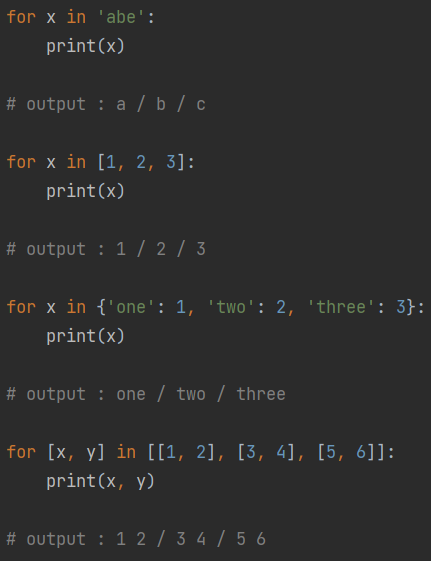반응형
Using "for" Loops in Python

Table of Contents
* Code is basically composed of <input # output> format.
Basic Form (1): for in
for variable in object:
statement- Here, the object typically refers to a string, list, tuple, or dictionary.
- The variable is sequentially assigned values from the first to the last index of the object.
- for x in 'abc': Here, x starts with 'a' and is subsequently assigned 'b' and 'c'.
- for x in [1, 2, 3]: Here, x starts with 1 and is subsequently assigned 2 and 3.
- for x in {'one': 1, 'two': 2, 'three': 3}: Here, x starts with 'one' and is subsequently assigned 'two' and 'three'.
- for [x, y] in [[1, 2], [3, 4], [5, 6]]: Here, x and y start with 1 and 2, and are subsequently assigned 3 and 4, then 5 and 6 respectively.
for x in 'abe':
print(x)
# output : a / b / c
for x in [1, 2, 3]:
print(x)
# output : 1 / 2 / 3
for x in {'one':1, 'two':2, 'three':3}:
print(x)
# output : one / two / three
for [x, y] in [[1, 2], [3, 4], [5, 6]]:
print(x, y)
# output : 1 2 / 3 4 / 5 6
Basic Form (2): for in range
for variable in range(start, end, step):
statement- The variable increments from (start) to (end-1) by (step), executing the statement each time.
- for i in range(0, 10, 1): Here, i starts from 0 and increments by 1 up to 9, executing the statement a total of 10 times.
- for variable in range(value1): If range() has one argument, it means end=value1, start=0, and step=1.
- for variable in range(value1, value2): If range() has two arguments, it means start=value1, end=value2, and step=1.
- You can omit the step, or omit both the start and step.
for i in range(0, 10, 2):
print(i)
# output : 0 / 2 / 4 / 6 / 8
for i in range(0, 10):
print(i)
# output : 0 / 1 / 2 / 3 / 4 / 5 / 6 / 7 / 8 / 9
for i in range(10):
print(i)
# output : 0 / 1 / 2 / 3 / 4 / 5 / 6 / 7 / 8 / 9
Basic Form (3): Nested "for" Loops
- You can include multiple "for" loops within a "for" loop.
for i in range(2):
for j in range(2):
for k in range(2):
print(i, j, k)
# output : 0 0 0 / 0 0 1 / 0 1 0 / 0 1 1 / 1 0 0 / 1 0 1 / 1 1 0 / 1 1 1
Functions Related to "for": continue, break
- continue: The statements following continue are not executed.
- break: Terminates the "for" loop.
- Generally, continue skips a particular moment in the "for" loop, while break cancels the remaining iterations of the "for" loop entirely.
for i in range(3):
if i == 1:
continue
print(i)
# output : 0 / 2
for i in range(10):
if i == 3:
break
print(i)
# output : 0 / 1 / 2
Functions Related to "for": else
- else: Executed after the "for" loop completes normally. It is not executed if the "for" loop is terminated by a break statement.
for x in [1, 2, 3]:
print(x)
else:
print('end')
# output : 1 / 2 / 3 / end
for x in [1, 2, 3]:
if x == 2:
break
print(x)
else:
print('end')
# output : 1
List Comprehension
[expression for variable1 in object1 if condition1
for variable2 in object2 if condition2
......
for variablen in objectn if conditionn]- As shown above, [for variable in object if condition] can consist of two or more clauses.
- The if condition part is optional.
a = 'abcde'
b = [val + 'k' for val in a]
print(b)
# output : ['ak', 'bk', 'ck', 'dk', 'ek']
a = [1, 2, 3, 4, 5]
b = [val * 5 for val in a]
print(b)
# output : [5, 10, 15, 20, 25]
a = 'abcde'
b = [val + 'k' for val in a if val == 'c']
print(b)
# output : ['ck']
a = [1, 2, 3, 4, 5]
b = [val * 5 for val in a if val < 3]
print(b)
# output : [5, 10]
a1 = [1, 2, 3]
a2 = [6, 7 ,8]
b = [val1 + val2 for val1 in a1 if val1 < 3
for val2 in a2 if val2 < 7]
print(b)
# output : [7, 8]
# The order of (val1, val2) is (1,6), (1,7), (1,8), (2,6), (2,7), (2,8), (3,6), (3,7), (3,8),
# and only (1,6) and (2,6) are selected according to each condition.
반응형
'개발 > Python' 카테고리의 다른 글
| [Python] Comprehensive Guide to Using "if" (3) | 2024.07.24 |
|---|---|
| [파이썬, Python] pdb 활용법 총정리 (1) | 2024.07.17 |
| [파이썬, Python] assert 활용법 총정리 (0) | 2024.07.17 |
| [파이썬, Python] 제너레이터 활용법 총정리 (0) | 2024.07.15 |
| [파이썬, Python] 디버깅 예시 총정리 (3) | 2024.07.15 |
